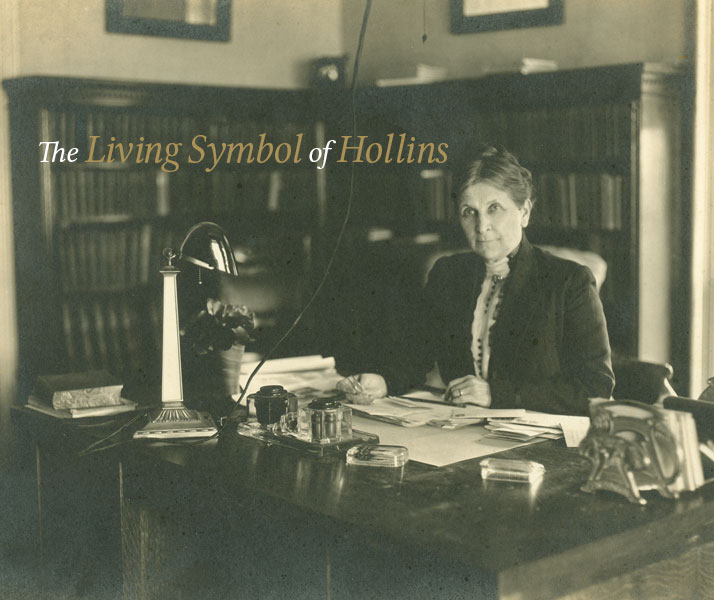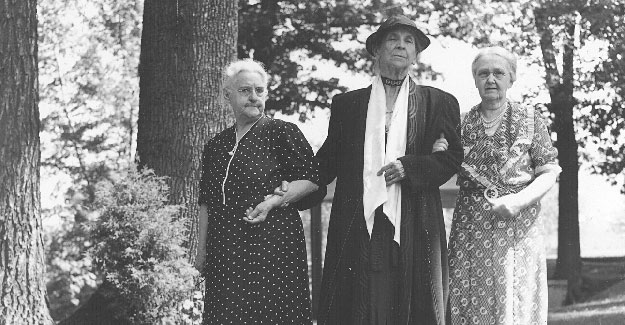
The Living Symbol of Hollins

Miss Matty, probably in the 1930s. Her companions are not identified.
The Living Symbol of Hollins
Martha “Miss Matty” Cocke succeeded her father as president of Hollins, becoming the first woman college president in Virginia. Although reluctant to take on such a visible role, she oversaw many fundamental changes in the institution she led for 32 years.
By Beth Harris
Martha Louisa “Matty” Cocke was born on October 9, 1855, the seventh of nine children of Charles Lewis and Susanna Pleasants Cocke. More than a month later, Cocke wrote a letter to his father, mentioning, almost as a footnote, the birth of Matty: “We have fallen heir to a new legacy which although highly prised may some day or other bring us into debt—another daughter.”
Matty Cocke received her entire education at Hollins. As a young girl, she was tutored by her older sister. She began taking classes in the preparatory department in 1865, at age 10. By the next year, however, she was eligible to take classes in the collegiate department. Over several years Matty earned six departmental diplomas: French, Latin, English language and literature, mathematics, natural science, and history. Matty received her full diploma in 1874, one of two awarded that year. Upon graduation, she provided secretarial assistance to her father. From 1876 to 1880, she taught classes in mathematics, English, French, and German. In 1884, her duties were expanded to include the roles of registrar and librarian.
The years 1899-1900 were a turning point for the Cockes. Three of Matty’s siblings died unexpectedly, including Charles Henry Cocke, who served as business manager for Hollins. Charles Henry had been the obvious choice to be the next president and was described by his father as his “right arm of strength.” Instead of designating a new successor, Charles Lewis named Matty, her brother Lucian, and nephews Estes and Joseph as trustees in his will, leaving them to make the decision. When her father died on May 4, 1901, Matty was elected president.
The following year Matty announced that Hollins would “…be conducted upon the same lines of conservative progress that have characterized its history for more than half a century.” In fact, much progress occurred during her tenure as president, but making the transition to president was not easy.
Raised in the Old South, she did not fit the image of college president. Additionally, she was born and raised on campus, thus insulated from the world. A member of the faculty, John McBryde, described her as “modest and retiring,” noting that she initially found it difficult to preside over faculty meetings. As a southern woman, she was not a public person and preferred to be called “Miss Matty.” She made few speeches and seldom attended academic functions. Although she overcame her initial difficulties, she continued to rely heavily on the advice of her brother and nephews.
Despite these limitations, Hollins experienced tremendous growth during her tenure, including the construction of 14 buildings and numerous renovations. In 1903, the A.B. degree was instituted and a new charter drafted. The year 1911 saw the change from Hollins Institute to Hollins College. The preparatory department was eliminated in 1920, and a four-year college curriculum was established. Finally, in 1932, the college transferred from private to public ownership and became fully accredited.
While she may have been “retiring,” Matty held on to her father’s ideals of a rigorous education for women. One student’s father complained that Hollins’ course offerings were too difficult. As a faculty member, Bessie Carter Randolph, who later served as Hollins’ third president, recalled how Miss Matty responded: “I am writing Mr. X to say that if he continues to request that his daughter be placed only in courses he imagines she can pass successfully, I shall request him to withdraw her at once from this college.” In another letter to a parent, Miss Matty reaffirmed her vision of Hollins: “To implant in those who are sent here for guidance, true principles, and high ideals of life, and to prepare them to take their places in any sphere in life to which they may be called.”
While Miss Matty had a strong sense of duty to fulfill her father’s wishes for Hollins, she continued to struggle with her role as president. She wrote to a friend, “The responsibility which I have been called upon to shoulder weighs more heavily each year as I more and more fully realize the greatness of it…I instinctively shrink from the office I hold, feeling as I do all the time that I fall short of reaching the ideal I have before me, and yet…I feel impelled to go forward in the works he so loved and sacrificed so much for, with all the strength and vigor that God has given me.”
As promised, she oversaw conservative progress in all areas of campus life. John McBryde noted that she was successful in balancing the “cherished traditions of the past” with the changing social climate. Frances Niederer, who taught art history at Hollins for many years, believed that Miss Matty’s hands-off approach enabled student initiatives to flourish. For example, students wanted a theatre and gym, a low priority for the administration. The students persisted, however, and helped raise much of the money for both buildings. A student government association was established in 1913 and a campus newspaper in 1928. Students also voted to disband sororities in 1929, believing that such organizations divided the campus.
Miss Matty took a strong interest in the students, maintaining the paternalistic atmosphere her father established. She wrote to a parent, “I feel a personal interest in every pupil of the school, and am always anxious to do all in my power to promote their welfare and happiness.” It is clear that the students were fond of Miss Matty. Before it was disbanded, the preparatory department named its literary society for her, and in 1930 students began the tradition of singing to her every year on her birthday.
Once Hollins became fully accredited, Miss Matty decided to retire in 1933, at age 78, knowing that Hollins was in good hands under the new president, Bessie Carter Randolph. Happy to retire, she admitted to a friend, “I’ve done my best. Yes, I am glad to let present-day problems rest on younger shoulders.” On August 15, 1938, she died in her sleep at age 83.
Miss Matty was president of Hollins for 32 years, but she served Hollins all her life. She received high praise for her accomplishments and character. The Richmond Times News Leader reported that Miss Matty was the first woman president in Virginia and “probably one of the first in the South.” The Roanoke Times praised her: “We know of no woman of whom it can more fittingly be said that she truly represented all that was best and finest in the womanhood of Virginia and the South.” The Richmond Times-Dispatch noted, “She is remembered…for her ‘dignity and serenity.’” As a final tribute, an alumna declared “So closely was she to be identified with the school that as the years went by she was to become for Hollins girls all over the country, the living symbol of their Alma Mater and the personal actuality of their ideas for educated womanhood.”
Beth Harris is Hollins’ special collections librarian and archivist. This article is an edited version of the article that originally appeared in the Dictionary of Virginia Biography, vol. 3, edited by Sara B. Bearss et al., 334-335, Richmond: Library of Virginia, 2006.
Miss Matty’s Circle
Miss Matty’s Circle recognizes recent alumnae who are leadership donors; these donors enjoy full membership in the 1842 Society. All members of the 1842 Society and Miss Matty’s Circle are invited to a special cocktail reception celebrating their dedication to Hollins at the president’s house the Friday evening of reunion, and to an annual weekend celebration exclusively for these leadership-level donors. Members are also listed in a prominent location in the Annual Report on Giving and receive a ribbon to wear at reunion signifying their membership in this society.
Miss Matty’s Circle Giving Levels
1-4 Years*: $250-$1,841
5-9 Years*: $500-$1,841
10-14 Years*: $1,000-$1,841
* Years since graduation
